 |
Search the Site with

|
USS Kearsarge (CV 33)
- later CVA 33, CVS 33 -- decommissioned -
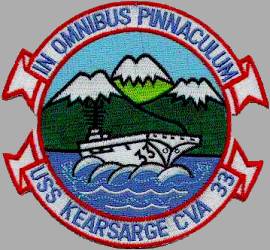 | 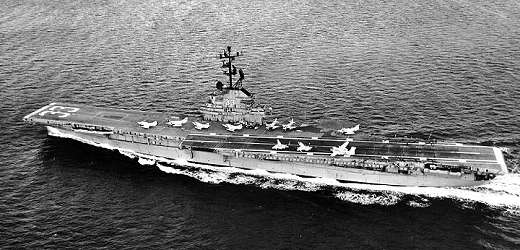 |
USS KEARSARGE was the 16th ESSEX - class aircraft carrier and the third ship in the Navy to bear the name. KEARSARGE was redesignated as attack aircraft carrier CVA 33 on October 1, 1952, and antisubmarine warfare aircraft carrier CVS 33 in October 1958. Made redundant by the general fleet drawdown of the late 1960s and early 1970s, USS KEARSARGE was decommissioned on February 13, 1970. Following three years in the Reserve Fleet, she was stricken from the Naval Vessel Register in May 1973 and sold for scrapping in February 1974.
| General Characteristics: | Awarded: 1942 |
| Keel laid: March 1, 1944 | |
| Launched: May 5, 1945 | |
| Commissioned: March 2, 1946 | |
| Decommissioned: February 13, 1970 | |
| Builder: New York Naval Shipyard, Camden, NJ | |
| Propulsion system: 8 boilers | |
| Propellers: four | |
| Aircraft elevators: three | |
| Arresting gear cables: four | |
| Catapults: two | |
| Length: 888.5 feet (270.8 meters) | |
| Flight Deck Width: 191.9 feet (58.5 meters) | |
| Beam: 101 feet (30.8 meters) | |
| Draft: 30.8 feet (9.4 meters) | |
| Displacement: approx. 40,600 tons full load | |
| Speed: 33 knots | |
| Planes: 80-100 planes | |
| Crew: approx. 3448 as CVS: 115 officers and 1500 enlisted | |
| Armament: see down below |
Crew List:
This section contains the names of sailors who served aboard USS KEARSARGE. It is no official listing but contains the names of sailors who submitted their information.
- Click here to view the list.
- Click here
to see which USS KEARSARGE memorabilia are currently for sale on ebay.
USS KEARSARGE Cruise Books:
- Midshipmen's Practice Cruise Book 1947
- Mediterranean Cruise Book 1948
- WestPac Cruise Book 1952-53
- WestPac Cruise Book 1953-54
- WestPac Cruise Book 1954-55
- WestPac Cruise Book 1955-56
- WestPac Cruise Book 1957-58
- WestPac Cruise Book 1959-60
- WestPac Cruise Book 1961
- WestPac Cruise Book 1964
- WestPac Cruise Book 1966
- WestPac Cruise Book 1967-68
- WestPac Cruise Book 1969
About the different armament:
- 1946: 12 5-inch (12.7 cm) 38 caliber guns and 40 40mm guns
- 1952: 8 5-inch (12.7 cm) 38 caliber guns and 20 3-inch (7.6 cm) 50 caliber guns
- 1954: 8 5-inch (12.7 cm) 38 caliber guns and 16 3-inch (7.6 cm) 50 caliber guns
- 1961: 7 5-inch (12.7 cm) 38 caliber guns
- 1966: 4 5-inch (12.7 cm) 38 caliber guns
Accidents aboard USS KEARSARGE:
| Date | Where | Events |
|---|---|---|
| November 5, 1962 | off California | USS KEARSARGE and USS MATTAPONI (AO 41) are slightly damaged in a collision during refueling. |
| December 3, 1962 | off Long Beach, Calif. | USS KEARSARGE and the SS ORIANA collide in dense fog. ORIANA suffers a 20-foot hole near its bow and the KEARSARGE suffers a 25-foot rip about ten feet aft on the starboard side. |
| December 23, 1967 | Sasebo, Japan | USS KEARSARGE suffers a fire while docked in Sasebo, Japan, for the holidays, killing three and injuring two. |
History of USS KEARSARGE:
USS KEARSARGE was launched 5 May 1945 by the New York Naval Shipyard, New York; sponsored by Mrs. Aubrey W. Fitch; and commissioned 2 March 1946, Captain Francis J. McKenna in command.
KEARSARGE arrived at her homeport, Norfolk, 21 April 1946, and for the next year engaged in training operations along the east coast and Caribbean. She cleared Norfolk 7 June 1947 on a midshipmen training cruise to the United Kingdom. Upon her return to the United States in August, the carrier engaged in maneuvers for 10 months before departing Hampton Roads 1 June 1948 for duty with the 6th Fleet.
During her tour in the Mediterranean, units of the 6th Fleet were placed on alert to insure peace in the Arab-Israeli area. KEARSARGE returned Quonset Point, R.I., 2 October 1948, and operated along the Atlantic Coast and the Caribbean until 27 January 1950 when she sailed for the west coast. The carrier arrived at the Puget Sound Navy Yard 23 February, and decommissioned there 16 June 1950 for a modernization overhaul that would enable her to handle new jet aircraft.
KEARSARGE recommissioned 15 February 1952, Captain Louis B. French in command. Following shakedown, the carrier cleared San Diego 11 August for intensive flight training in the Hawaiian Islands. Her readiness complete, she sailed for the Far East to engage in combat missions in the Korean War. Arriving Yokosuka 8 September 1952, KEARSARGE joined the fast carrier Task Force 77 off the east coast of Korea six days later. For the next five months, the carrier's planes flew nearly 6,000 sorties against Communist forces in North Korea, unleashing considerable damage on enemy positions. She completed her tour in late February 1953, returning to her homeport, San Diego 17 March. While serving in Korea her classification was changed to CVA 33.
KEARSARGE sailed again for the Far East 1 July 1953 and operated with the 7th Fleet fast carrier force during the uneasy truce in Korea. The "Mighty Kay" also kept watch over the Formosa Straits to prevent the Communists from interfering with the Chinese Nationalists on Taiwan. KEARSARGE returned San Diego, 18 January 1954, to resume training operations off California.
Clearing San Diego 7 October 1954, she steamed toward her third deployment to the Far East. While operating with the 7th Fleet, the carrier stood by to assist the Nationalist Chinese in the evacuation of the Tachen Islands. From 6 to 13 February 1955, KEARSARGE supported units of the fleet in the successful evacuation of 18,000 civilians and 20,000 military personnel from the islands. Her cruise ended at San Diego 12 May. The carrier was again modernized in 1956-57, receiving an enclosed "hurricane" bow and an angled flight deck to better equip her to operate high-performance aircraft.
KEARSARGE was assigned a new role in October 1958, becoming an anti-submarine warfare (ASW) support aircraft carrier, with the new designation CVS 33. Following intensive training in her new role, the carrier sailed 5 September 1959 for 7th fleet operations in the Far East. Early in her tour, Japan was hit with a violent typhoon, and KEARSARGE played an important role in providing relief to the victims. Her planes landed parties of medical and supply units, while her crew and air group donated clothing and money to the distressed people. After participating in SEATO exercises and 7th Fleet operations, she cleared Yokosuka, 3 March 1960, for her homeward voyage. Three days later in stormy waters 1,200 miles off Wake Island, four Russians were rescued after drifting 49 days in disabled landing craft. They were flown back to their country after KEARSARGE arrived Alameda, Calif., 15 March; and the carrier received thanks from the Soviet Union for this gesture.
A year of training operations preceded her next deployment from San Diego which began 3 March 1961. The anti-submarine carrier steamed to Southeast Asian waters as the Communists intensified their effort to overthrow the government in Laos. The power and determination of the 7th Fleet was observed by the enemy and the crisis eased. Peace prevailed. After 6 months in the Far East, KEARSARGE arrived Puget Sound 1 November for the second phase of her modernization. Upon completion of repairs and training, KEARSARGE departed Long Beach, 1 August 1962, to station herself in the Pacific missile range as a recovery ship in the Mercury orbital space flight of astronaut Walter Schirra. In October, after a flawless flight, the carrier played her role in the space age by retrieving Schirra and his capsule and returning him to Honolulu for flight back to the States.
KEARSARGE resumed training exercises, continuing these for six months before arriving Pearl Harbor 29 April 1963 to once again take part in the space program. The carrier repeated her earlier recovery by plucking astronaut Gordon Cooper on 18 May 1963, after he orbited the earth 22 times in his capsule Faith 7. She returned the space hero to Pearl Harbor, then departed 4 June on her eighth cruise to the Far East. Operations with the 7th Fleet included keeping watch on the unsettled problems in Southeast Asia. KEARSARGE returned Long Beach, 3 December, for training exercises off California.
Six months later, 19 June 1964, the anti-submarine carrier was deployed on her ninth Far Eastern cruise. Arriving Yokosuka 30 July, KEARSARGE was dispatched to the South China Sea, following the North Vietnamese patrol boat attack on U.S. destroyers in the Gulf of Tonkin. While U.S. Navy planes destroyed North Vietnam oil and supply depots, KEARSARGE provided anti-submarine protection for the 7th Fleet. The decisiveness of American action persuaded the Communists to delay their objectives for the time being; and KEARSARGE returned Long Beach, 16 December 1964.
After overhaul during the first half of 1965, KEARSARGE operated off the West Coast until sailing for the Far East 9 June 1966. Steaming via Hawaii and Japan, she reached "Yankee Station" 8 August and operated off Vietnam through 24 October. The next day she headed for the Kuala Lumpur area and anchored in the Strait of Malacca on the 30th. She returned via Subic Bay to "Yankee Station" 5 November and operated there through the 23d. The next day, the carrier started home via Hong Kong and Japan, arriving San Diego 20 December 1966. She operated on the west coast until departing San Diego 18 August 1967 and reached Pearl Harbor 10 days later to prepare for future action.
Made redundant by the general fleet drawdown of the late 1960s and early 1970s, USS KEARSARGE was decommissioned 13 February 1970. Following three years in the Reserve Fleet, she was stricken from the Naval Vessel Register in May 1973 and sold for scrapping in February 1974.
KEARSARGE received two battle stars for Korean War service.
USS KEARSARGE Patch Gallery:
 |
USS KEARSARGE Image Gallery:
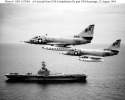 | 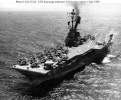 | 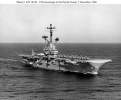 | 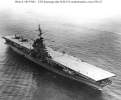 |  |
 Back to Carriers list.
Back to Carriers list.